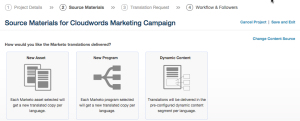Early Adopters of New Marketing Technology Earn Their Bragging Rights
4 min read
The speed at which a business operates and its adoption of innovative technology go together hand-in-hand. We all marvel at how business ever managed to function efficiently prior to the invention of modern-day technologies we now take for granted, such as the Internet and its related software, programs and applications, and the laptops, smartphones and tablets that allow us to access it. All of which enable us to be more efficient workers who can drive more success in our business and professional lives.
 Business software, of course, and the evolution of SaaS (aka cloud software) and optimization platforms like ERP and CRM software has been a major game changer in the management of sales and business data since the early 2000’s. In the late 2000’s, marketing software began to take center stage, and early adopters of marketing automation tools have benefitted from their wise investments -- B2B marketers who implement marketing automation increase their sales-pipeline contribution by 10%.(1) That’s something to brag about.
Business software, of course, and the evolution of SaaS (aka cloud software) and optimization platforms like ERP and CRM software has been a major game changer in the management of sales and business data since the early 2000’s. In the late 2000’s, marketing software began to take center stage, and early adopters of marketing automation tools have benefitted from their wise investments -- B2B marketers who implement marketing automation increase their sales-pipeline contribution by 10%.(1) That’s something to brag about.
A Growing Demand to Simplify a Complex Task
As more consumers had access to the Internet via computers and mobile devices, the age of digital marketing began to take off in the late 1990’s, early 2000’s. Now, in addition to the traditional marketing channels (trade shows, print ads, and mailings), marketers were responsible for managing digital marketing channels, too (mobile SMS messaging, email, landing pages, etc.). At the time, there was no efficient process to manage the growing array of tools, reports and responsibilities, or a way to track and monitor spend to maximize ROI.
So marketers tolerated a laborious and time-consuming process of managing all of it via disparate, inefficient makeshift solutions to maintain lists and produce reports, like Excel spreadsheets, and copying and pasting email content into different batches for email blasts that they hoped were reaching the right target audiences. It was around this time that marketing automation software was developed to simplify the process of what was fast becoming a complex and disjointed marketing strategy, allowing companies to more effectively touch vastly larger audiences in a fraction of the time.
The Early Adopter Reaps the Benefits
Like any new technology, it took very forward-looking and innovative organizations -- the early pioneers -- to fully adopt marketing automation software. Then, as the pioneers’ success was being witnessed and publicized, huge numbers of companies followed suit. Suddenly everyone wanted marketing automation platforms, and the software evolved to be more powerful than ever, providing increased marketing capabilities and impact on top-line revenue.
The adoption of marketing automation platforms has increased exponentially -- I’m hard-pressed to find a mid- to large-size company that doesn’t use it, especially companies who are very growth oriented. In fact, one study shows nearly 70% of businesses are using a marketing automation platform or are currently implementing one.(2)
Moreover, a decade ago marketers didn't automatically include “marketing automation software” as a budgetary line item. Just like any new technology investment or budget consideration, the vast majority of marketing leaders had to show its value to the organization: What’s the ROI? Or, to quote a Tom Cruise favorite, Jerry Maguire, “Show me the money!” So only those with the most enterprising attitudes and a track record of spotting great technologies could become those “pioneers” who could reap the early benefits sans huge ROI or market-adoption data to support their un-budgeted purchase. Kudos to them.
Now, nearly every marketing budget includes it because in addition to increased lead gen, sales and revenue, marketing automation has allowed marketers to market more by automating processes, saving time and money -- and freeing up employees to conceive and implement more campaigns. I think you see where I’m going here.
Stop Tolerating an Archaic Process
So to me, that begs the question, if modern marketers have adopted software to automate -- and optimize -- digital marketing efforts, why are they, in 2015, still using 1990’s office productivity software to manage the translation process for ALL of the same marketing content they’ve put into the marketing automation platform they use to streamline and turbocharge their lead generation operation? So you buy marketing automation to scale, but can’t hit the gas globally because your global content process is stuck in neutral?
The benefits of a marketing globalization platform are evident and the investment pays off. Just as early adopters of marketing automation had to do 10 years ago, your forward-thinking efforts to include (or fight to carve out) a marketing globalization platform as a line item in your budget will allow you to reduce translation costs, increase productivity, and launch more global campaigns in more markets faster and more frequently, which leads to faster international revenue growth.
Just as marketing automation delivers insight through analytics and reports, allowing marketers to measure the revenue contribution of each campaign, marketing channel and associated marketing content piece, Cloudwords’ marketing globalization platform delivers global marketers a single view and analytics into all of their translation and processes worldwide, so they can more effectively plan, localize and execute multi-channel campaigns on a global scale.
No other solution gives marketers complete visibility into the localization process to ensure translations are progressing; identify bottlenecks early on so they can be avoided; and optimize processes to continually improve timelines, cost-effectiveness and results of global programs in order to help marketers predict what will work best in each market.
Earn Bragging Rights
It’s only been 10 years or so since marketing automation was introduced to the market, and now there are more than 70 different marketing automation solutions available to help marketers optimize the way they communicate with audiences and customers. Cloudwords customers should feel proud -- they are the early adopters, the pioneers on the cusp of a new era in global marketing, who already recognize that executing a better global content operation is key to international success. They’ve earned their bragging rights. What’s stopping you?
Footnotes:
(1) Forrester Research “The Forrester Wave Lead-To-Revenue Management Platform Vendors” (2014)
(2) Aberdeen Group “State of Marketing Automation 2014: Processes that Produce” (2014)



